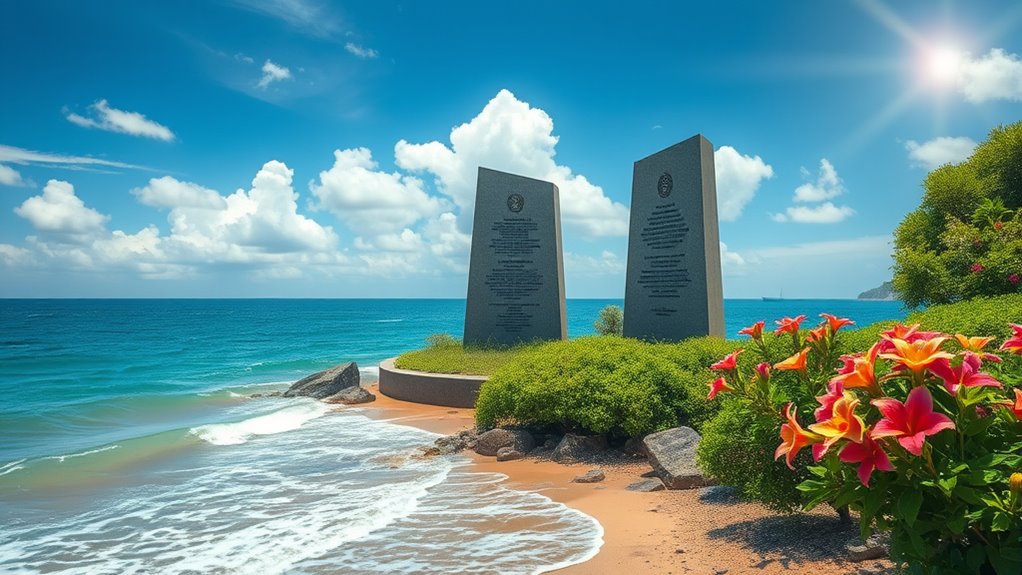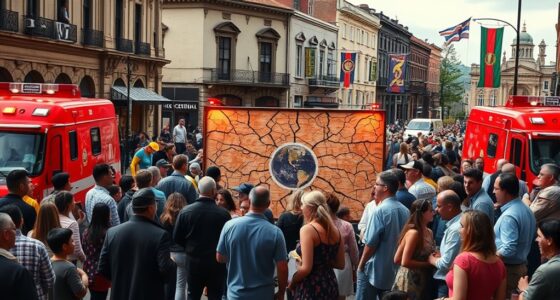The Indian Ocean Tsunami Memorial doesn’t just honor the victims of the 2004 disaster; it actively promotes disaster preparedness. By encouraging community engagement through awareness campaigns and preparedness drills, the memorial fosters a culture of readiness. It highlights the lessons learned from past tragedies, ensuring future generations are better equipped to handle natural disasters. You’ll discover how this memorial serves as a call to action for resilience and international collaboration in disaster management.
Key Takeaways
- The memorial honors victims while emphasizing the importance of disaster preparedness in response to the 2004 tsunami tragedy.
- It supports initiatives like the Indian Ocean Tsunami Warning System to improve future disaster readiness.
- Community engagement programs encourage local involvement in tsunami preparedness and awareness campaigns.
- Scientific forums promote collaboration to develop effective disaster management strategies based on lessons learned from past events.
- The memorial serves as a symbol of resilience, inspiring ongoing efforts toward infrastructure development and ecological restoration for better preparedness.

When you visit the Indian Ocean Tsunami Memorial, you’re not just stepping into a park; you’re entering a space that honors the memory of those who lost their lives in the devastating 2004 tsunami. This memorial serves as a reminder of the tragic event that affected numerous countries across South and Southeast Asia. Triggered by a massive underwater earthquake off Sumatra, Indonesia, the tsunami resulted in significant loss of life and destruction. The memorial offers you a chance to reflect on the human cost of such natural disasters.
One of the most impactful aspects of the memorial is its connection to a broader initiative aimed at improving disaster preparedness. The tragedy of 2004 prompted a global response that led to the establishment of the Indian Ocean Tsunami Warning and Mitigation System in 2005. When you walk through the memorial, you can appreciate the efforts made internationally to enhance tsunami warning systems and guarantee that communities are better prepared for future emergencies.
The memorial also highlights the importance of community awareness. Programs like Tsunami Ready Recognition encourage local communities to engage in disaster preparedness drills and awareness campaigns. You’ll see that this isn’t just about remembering the past; it’s about creating a safer future for everyone. This sense of community preparedness is crucial in mitigating the effects of potential tsunamis and guaranteeing that people know how to respond when disaster strikes.
Moreover, visiting the memorial can inspire you to think about the role of science and planning in disaster management. Forums organized by organizations like the Woods Hole Oceanographic Institution focus on coastal disaster management and promote collaboration between natural and social scientists. You’ll find that the lessons learned from the 2004 tsunami continue to inform new strategies for disaster resilience and recovery.
As you explore the memorial, you may also notice various elements that symbolize hope and resilience. The memorial wall, bearing the names of over 1,400 victims, serves as a poignant reminder of the lives lost while also encouraging ongoing efforts for ecological restoration and infrastructure development designed with disaster resilience in mind.
In essence, the Indian Ocean Tsunami Memorial isn’t just a place for remembrance; it’s a call to action. It reminds us that preparedness, awareness, and international collaboration can make a difference when faced with natural disasters.
Frequently Asked Questions
How Can I Get Involved in Tsunami Preparedness Initiatives?
You can get involved in tsunami preparedness initiatives by participating in local drills to practice evacuation procedures.
Support community organizations focused on disaster response and volunteer for training programs that teach first aid.
Help create educational materials to raise awareness about tsunami risks and attend public forums to discuss preparedness.
Additionally, consider collaborating with tech companies to develop early warning systems or mobile apps that enhance communication during emergencies.
Your involvement makes a difference!
What Resources Are Available for Tsunami Education?
There are plenty of resources available for tsunami education. You can check out the Tsunami Smart Teacher Education Resource Kit, which offers lesson plans for grades 6-8.
The Tsunami Curriculum by Washington State EMD is great for all K-12 students. UNESCO’s educational materials cater to various age groups too.
Additionally, you might find the Natural Disasters Puzzle Book and coastal hazard posters by USGS useful in raising awareness and understanding of tsunamis.
Are There Any Volunteer Opportunities at the Memorial?
Yes, there are volunteer opportunities at the memorial.
You can participate in various activities, from supporting educational programs to maintaining the site. Engaging with the local community, you’ll help raise awareness about disaster preparedness and recovery efforts.
You might even assist in organizing events that reflect on the past while promoting resilience.
Volunteering at the memorial lets you contribute meaningfully, honoring those affected while fostering a spirit of hope and unity.
How Often Are Tsunami Drills Conducted in Affected Regions?
In Indonesia, communities in high-risk areas conduct tsunami drills regularly, with some regions participating every six months.
You’ll find that countries like Thailand and Sri Lanka also prioritize these exercises, with annual drills forming a key part of their disaster management plans.
What Is the History of the Indian Ocean Tsunami?
The Indian Ocean tsunami of 2004 was triggered by a massive undersea earthquake off Sumatra, Indonesia, with a magnitude of 9.1. This disaster struck on December 26, affecting 15 countries and causing over 228,000 casualties.
You’d see waves reaching heights of up to 30 meters, devastating coastal regions.
The aftermath revealed significant gaps in early warning systems and highlighted the need for improved disaster response and preparedness worldwide.
Conclusion
As you stand before the Indian Ocean Tsunami Memorial, let its powerful presence prompt profound reflections on preparedness. Remembering the past helps us face future fears. By cultivating a culture of caution, we can protect precious lives and guarantee safety during sudden surges. Embrace the lessons learned, and together, let’s build a brighter, bolder tomorrow. With awareness and action, we’ll weather any wave, transforming tragedy into triumph through teamwork and tenacity.










